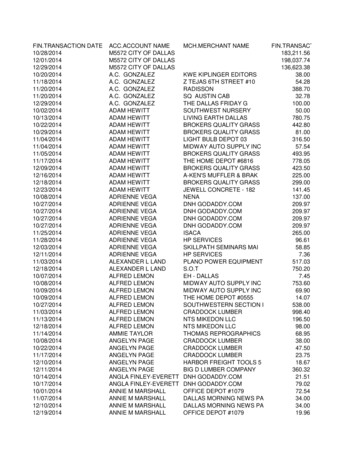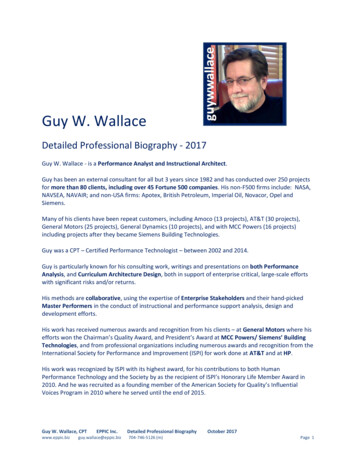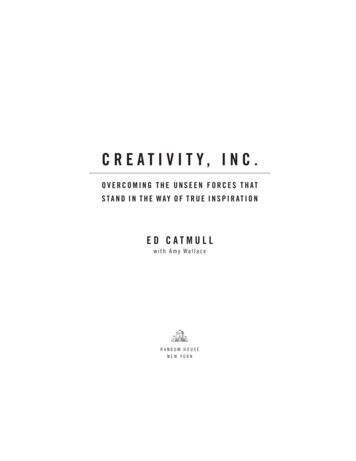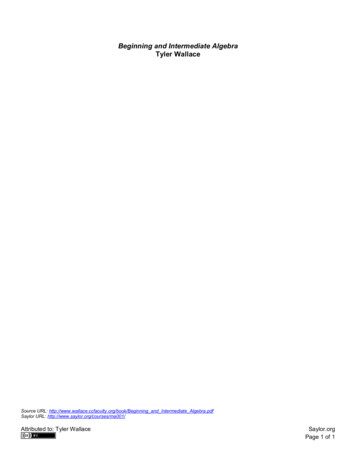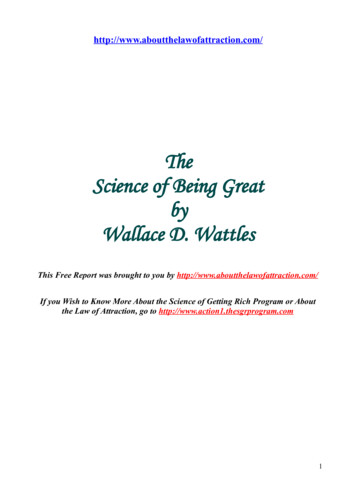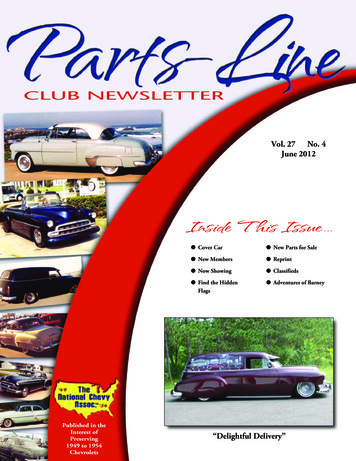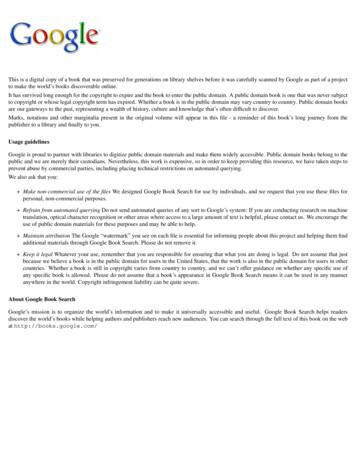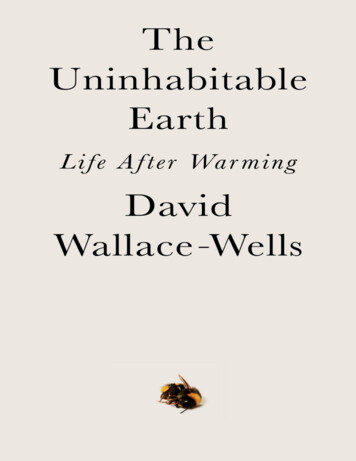
Transcription
Copyright 2019 by David Wallace-WellsAll rights reserved.Published in the United States by Tim Duggan Books, an imprint of the Crown Publishing Group,a division of Penguin Random House LLC, New York.crownpublishing.comTIM DUGGAN BOOKS and the Crown colophon are trademarks of Penguin Random House LLC.Library of Congress Cataloging-in-Publication Data.Names: Wallace-Wells, David, author.Title: The uninhabitable earth : life after warming / David Wallace-Wells.Description: First edition. New York : Tim Duggan Books, 2019. Includes bibliographicalreferences.Identifiers: LCCN 2018051268 ISBN 9780525576709 (hardback) ISBN 9780525576723 (ebook)Subjects: LCSH: Nature--Effect of human beings on. Global warming--Social aspects. Climaticchanges--Social aspects. Global environmental change--Social aspects. Environmentaldegradation--Social aspects. BISAC: NATURE / Environmental Conservation & Protection.Classification: LCC GF75 .W36 2019 DDC 304.2/8--dc23LC record available at https://lccn.loc.gov/2018051268ISBN 9780525576709Ebook ISBN 9780525576723International edition ISBN 9781984826589Cover design by Richard GreenCover photograph: Paustius/Shutterstockv5.4a
For Risa and Rocca,My mother and father
ContentsCoverTitle PageCopyrightDedicationI. CascadesII. Elements of ChaosHeat DeathHungerDrowningWildfireDisasters No Longer NaturalFreshwater DrainDying OceansUnbreathable AirPlagues of WarmingEconomic CollapseClimate Conflict“Systems”III. The Climate KaleidoscopeStorytellingCrisis CapitalismThe Church of Technology
Politics of ConsumptionHistory After ProgressEthics at the End of the WorldIV. The Anthropic PrincipleAcknowledgmentsNotes
ICascades
It is worse, much worse, than you think. The slowness of climatechange is a fairy tale, perhaps as pernicious as the one that says it isn’thappening at all, and comes to us bundled with several others in ananthology of comforting delusions: that global warming is an Arctic saga,unfolding remotely; that it is strictly a matter of sea level and coastlines,not an enveloping crisis sparing no place and leaving no life undeformed;that it is a crisis of the “natural” world, not the human one; that those twoare distinct, and that we live today somehow outside or beyond or at thevery least defended against nature, not inescapably within and literallyoverwhelmed by it; that wealth can be a shield against the ravages ofwarming; that the burning of fossil fuels is the price of continuedeconomic growth; that growth, and the technology it produces, will allowus to engineer our way out of environmental disaster; that there is anyanalogue to the scale or scope of this threat, in the long span of humanhistory, that might give us confidence in staring it down.None of this is true. But let’s begin with the speed of change. The earthhas experienced five mass extinctions before the one we are livingthrough now, each so complete a wiping of the fossil record that itfunctioned as an evolutionary reset, the planet’s phylogenetic tree firstexpanding, then collapsing, at intervals, like a lung: 86 percent of allspecies dead, 450 million years ago; 70 million years later, 75 percent;125 million years later, 96 percent; 50 million years later, 80 percent; 135million years after that, 75 percent again. Unless you are a teenager, youprobably read in your high school textbooks that these extinctions werethe result of asteroids. In fact, all but the one that killed the dinosaursinvolved climate change produced by greenhouse gas. The most notoriouswas 250 million years ago; it began when carbon dioxide warmed theplanet by five degrees Celsius, accelerated when that warming triggeredthe release of methane, another greenhouse gas, and ended with all but asliver of life on Earth dead. We are currently adding carbon to theatmosphere at a considerably faster rate; by most estimates, at least tentimes faster. The rate is one hundred times faster than at any point in
human history before the beginning of industrialization. And there isalready, right now, fully a third more carbon in the atmosphere than atany point in the last 800,000 years—perhaps in as long as 15 millionyears. There were no humans then. The oceans were more than ahundred feet higher.Many perceive global warming as a sort of moral and economic debt,accumulated since the beginning of the Industrial Revolution and nowcome due after several centuries. In fact, more than half of the carbonexhaled into the atmosphere by the burning of fossil fuels has beenemitted in just the past three decades. Which means we have done asmuch damage to the fate of the planet and its ability to sustain human lifeand civilization since Al Gore published his first book on climate than inall the centuries—all the millennia—that came before. The United Nationsestablished its climate change framework in 1992, advertising scientificconsensus unmistakably to the world; this means we have nowengineered as much ruin knowingly as we ever managed in ignorance.Global warming may seem like a distended morality tale playing out overseveral centuries and inflicting a kind of Old Testament retribution on thegreat-great-grandchildren of those responsible, since it was carbonburning in eighteenth-century England that lit the fuse of everything thathas followed. But that is a fable about historical villainy that acquits thoseof us alive today—and unfairly. The majority of the burning has comesince the premiere of Seinfeld. Since the end of World War II, the figureis about 85 percent. The story of the industrial world’s kamikaze missionis the story of a single lifetime—the planet brought from seeming stabilityto the brink of catastrophe in the years between a baptism or bar mitzvahand a funeral.We all know those lifetimes. When my father was born in 1938—amonghis first memories the news of Pearl Harbor and the mythic air force ofthe industrial propaganda films that followed—the climate systemappeared, to most human observers, steady. Scientists had understoodthe greenhouse effect, had understood the way carbon produced byburned wood and coal and oil could hothouse the planet anddisequilibrate everything on it, for three-quarters of a century. But theyhad not yet seen the impact, not really, not yet, which made warmingseem less like an observed fact than a dark prophecy, to be fulfilled onlyin a very distant future—perhaps never. By the time my father died, in
2016, weeks after the desperate signing of the Paris Agreement, theclimate system was tipping toward devastation, passing the threshold ofcarbon concentration—400 parts per million in the earth’s atmosphere,in the eerily banal language of climatology—that had been, for years, thebright red line environmental scientists had drawn in the rampaging faceof modern industry, saying, Do not cross. Of course, we kept going: justtwo years later, we hit a monthly average of 411, and guilt saturates theplanet’s air as much as carbon, though we choose to believe we do notbreathe it.The single lifetime is also the lifetime of my mother: born in 1945, toGerman Jews fleeing the smokestacks through which their relatives wereincinerated, and now enjoying her seventy-third year in an Americancommodity paradise, a paradise supported by the factories of adeveloping world that has, in the space of a single lifetime, too,manufactured its way into the global middle class, with all the consumerenticements and fossil fuel privileges that come with that ascent:electricity, private cars, air travel, red meat. She has been smoking forfifty-eight of those years, unfiltered, ordering the cigarettes now by thecarton from China.It is also the lifetime of many of the scientists who first raised publicalarm about climate change, some of whom, incredibly, remain working—that is how rapidly we have arrived at this promontory. Roger Revelle,who first heralded the heating of the planet, died in 1991, but WallaceSmith Broecker, who helped popularize the term “global warming,” stilldrives to work at the Lamont-Doherty Earth Observatory across theHudson every day from the Upper West Side, sometimes picking uplunch at an old Jersey filling station recently outfitted as a hipster eatery;in the 1970s, he did his research with funding from Exxon, a companynow the target of a raft of lawsuits that aim to adjudicate responsibilityfor the rolling emissions regime that today, barring a change of course onfossil fuels, threatens to make parts of the planet more or less unlivablefor humans by the end of this century. That is the course we are speedingso blithely along—to more than four degrees Celsius of warming by theyear 2100. According to some estimates, that would mean that wholeregions of Africa and Australia and the United States, parts of SouthAmerica north of Patagonia, and Asia south of Siberia would be rendereduninhabitable by direct heat, desertification, and flooding. Certainly it
would make them inhospitable, and many more regions besides. This isour itinerary, our baseline. Which means that, if the planet was broughtto the brink of climate catastrophe within the lifetime of a singlegeneration, the responsibility to avoid it belongs with a single generation,too. We all also know that second lifetime. It is ours.—I am not an environmentalist, and don’t even think of myself as a natureperson. I’ve lived my whole life in cities, enjoying gadgets built byindustrial supply chains I hardly think twice about. I’ve never gonecamping, not willingly anyway, and while I always thought it wasbasically a good idea to keep streams clean and air clear, I also alwaysaccepted the proposition that there was a trade-off between economicgrowth and cost to nature—and figured, well, in most cases I’d probablygo for growth. I’m not about to personally slaughter a cow to eat ahamburger, but I’m also not about to go vegan. I tend to think whenyou’re at the top of the food chain it’s okay to flaunt it, because I don’t seeanything complicated about drawing a moral boundary between us andother animals, and in fact find it offensive to women and people of colorthat all of a sudden there’s talk of extending human-rights-like legalprotections to chimps, apes, and octopuses, just a generation or two afterwe finally broke the white-male monopoly on legal personhood. In theseways—many of them, at least—I am like every other American who hasspent their life fatally complacent, and willfully deluded, about climatechange, which is not just the biggest threat human life on the planet hasever faced but a threat of an entirely different category and scale. That is,the scale of human life itself.A few years ago, I began collecting stories of climate change, many ofthem terrifying, gripping, uncanny narratives, with even the most smallscale sagas playing like fables: a group of Arctic scientists trapped whenmelting ice isolated their research center, on an island populated also bya group of polar bears; a Russian boy killed by anthrax released from athawing reindeer carcass, which had been trapped in permafrost formany decades. At first, it seemed the news was inventing a new genre ofallegory. But of course climate change is not an allegory.Beginning in 2011, about one million Syrian refugees were unleashed
on Europe by a civil war inflamed by climate change and drought—and ina very real sense, much of the “populist moment” the entire West ispassing through now is the result of panic produced by the shock of thosemigrants. The likely flooding of Bangladesh threatens to create ten timesas many, or more, received by a world that will be even furtherdestabilized by climate chaos—and, one suspects, less receptive thebrowner those in need. And then there will be the refugees from subSaharan Africa, Latin America, and the rest of South Asia—140 million by2050, the World Bank estimates, meaning more than a hundred timesEurope’s Syrian “crisis.”The U.N. projections are bleaker: 200 million climate refugees by2050. Two hundred million was the entire world population at the peakof the Roman Empire, if you can imagine every single person alive andliving anywhere on the planet at that time dispossessed of their home andturned outward to wander through hostile territories in search of a newone. The high end of what’s possible in the next thirty years, the UnitedNations says, is considerably worse: “a billion or more vulnerable poorpeople with little choice but to fight or flee.” A billion or more. That wasthe entire global population as recently as 1820, with the IndustrialRevolution well under way. Which suggests that we might better conceiveof history not as a deliberate procession of years marching forward on atimeline but as an expanding balloon of population growth, humanitydilating across the planet almost to the point of full eclipse. One reasoncarbon emissions have accelerated so much in the last generation is alsoan explanation for why history seems to be proceeding so much faster,with so much more happening, everywhere, each year, even every day:this is what results when there are simply that many more humansaround. Fifteen percent of all human experience throughout history, it’sbeen estimated, belongs to people alive right now, each walking the earthwith carbon footprints.Those refugee figures are high-end estimates, produced years ago byresearch groups designed to call attention to a particular cause orcrusade; the true numbers will almost surely fall short of them, andscientists tend to trust projections in the tens of millions rather than thehundreds of millions. But that those bigger numbers are only the farupper reaches of what is possible should not lull us into complacency;when we dismiss the worst-case possibilities, it distorts our sense of
likelier outcomes, which we then regard as extreme scenarios we needn’tplan so conscientiously for. High-end estimates establish the boundariesof what’s possible, between which we can better conceive of what is likely.And perhaps they will prove better guides even than that, considering theoptimists have never, in the half century of climate anxiety we’ve alreadyendured, been right.My file of stories grew daily, but very few of the clips, even those drawnfrom new research published in the most pedigreed scientific journals,seemed to appear in the coverage about climate change the countrywatched on television and read in its newspapers. In those places, climatechange was reported, of course, and even with some tinge of alarm. Butthe discussion of possible effects was misleadingly narrow, limited almostinvariably to the matter of sea-level rise. Just as worrisome, the coveragewas sanguine, all things considered. As recently as the 1997 signing of thelandmark Kyoto Protocol, two degrees Celsius of global warming wasconsidered the threshold of catastrophe: flooded cities, cripplingdroughts and heat waves, a planet battered daily by hurricanes andmonsoons we used to call “natural disasters” but will soon normalize assimply “bad weather.” More recently, the foreign minister of the MarshallIslands offered another name for that level of warming: “genocide.”There is almost no chance we will avoid that scenario. The KyotoProtocol achieved, practically, nothing; in the twenty years since, despiteall of our climate advocacy and legislation and progress on green energy,we have produced more emissions than in the twenty years before. In2016, the Paris accords established two degrees as a global goal, and, toread our newspapers, that level of warming remains something like thescariest scenario it is responsible to consider; just a few years later, withno single industrial nation on track to meet its Paris commitments, twodegrees looks more like a best-case outcome, at present hard to credit,with an entire bell curve of more horrific possibilities extending beyond itand yet shrouded, delicately, from public view.For those telling stories about climate, such horrific possibilities—andthe fact that we had squandered our chance of landing anywhere on thebetter half of that curve—had become somehow unseemly to consider.The reasons are almost too many to count, and so half-formed they mightbetter be called impulses. We chose not to discuss a world warmedbeyond two degrees out of decency, perhaps; or simple fear; or fear of
fearmongering; or technocratic faith, which is really market faith; ordeference to partisan debates or even partisan priorities; or skepticismabout the environmental Left of the kind I’d always had; or disinterest inthe fates of distant ecosystems like I’d also always had. We felt confusionabout the science and its many technical terms and hard-to-parsenumbers, or at least an intuition that others would be easily confusedabout the science and its many technical terms and hard-to-parsenumbers. We suffered from slowness apprehending the speed of change,or semi-conspiratorial confidence in the responsibility of global elites andtheir institutions, or obeisance toward those elites and their institutions,whatever we thought of them. Perhaps we felt unable to really trustscarier projections because we’d only just heard about warming, wethought, and things couldn’t possibly have gotten that much worse justsince the first Inconvenient Truth; or because we liked driving our carsand eating our beef and living as we did in every other way and didn’twant to think too hard about that; or because we felt so “postindustrial”we couldn’t believe we were still drawing material breaths from fossil fuelfurnaces. Perhaps it was because we were so sociopathically good atcollating bad news into a sickening evolving sense of what constituted“normal,” or because we looked outside and things seemed still okay.Because we were bored with writing, or reading, the same story again andagain, because climate was so global and therefore nontribal it suggestedonly the corniest politics, because we didn’t yet appreciate how fully itwould ravage our lives, and because, selfishly, we didn’t mind destroyingthe planet for others living elsewhere on it or those not yet born whowould inherit it from us, outraged. Because we had too much faith in theteleological shape of history and the arrow of human progress tocountenance the idea that the arc of history would bend toward anythingbut environmental justice, too. Because when we were being really honestwith ourselves we already thought of the world as a zero-sum resourcecompetition and believed that whatever happened we were probablygoing to continue to be the victors, relatively speaking anyway,advantages of class being what they are and our own luck in the natalistlottery being what it was. Perhaps we were too panicked about our ownjobs and industries to fret about the future of jobs and industry; orperhaps we were also really afraid of robots or were too busy looking atour new phones; or perhaps, however easy we found the apocalypse reflex
in our culture and the path of panic in our politics, we truly had a goodnews bias when it came to the big picture; or, really, who knows why—there are so many aspects to the climate kaleidoscope that transforms ourintuitions about environmental devastation into an uncanny complacencythat it can be hard to pull the whole picture of climate distortion intofocus. But we simply wouldn’t, or couldn’t, or anyway didn’t look squarelyin the face of the science.—This is not a book about the science of warming; it is about what warmingmeans to the way we live on this planet. But what does that science say?It is complicated research, because it is built on two layers of uncertainty:what humans will do, mostly in terms of emitting greenhouse gases, andhow the climate will respond, both through straightforward heating and avariety of more complicated, and sometimes contradictory, feedbackloops. But even shaded by those uncertainty bars it is also very clearresearch, in fact terrifyingly clear. The United Nations’Intergovernmental Panel on Climate Change (IPCC) offers the goldstandard assessments of the state of the planet and the likely trajectoryfor climate change—gold-standard, in part, because it is conservative,integrating only new research that passes the threshold of inarguability. Anew report is expected in 2022, but the most recent one says that if wetake action on emissions soon, instituting immediately all of thecommitments made in the Paris accords but nowhere yet actuallyimplemented, we are likely to get about 3.2 degrees of warming, or aboutthree times as much warming as the planet has seen since the beginningof industrialization—bringing the unthinkable collapse of the planet’s icesheets not just into the realm of the real but into the present. That wouldeventually flood not just Miami and Dhaka but Shanghai and Hong Kongand a hundred other cities around the world. The tipping point for thatcollapse is said to be around two degrees; according to several recentstudies, even a rapid cessation of carbon emissions could bring us thatamount of warming by the end of the century.The assaults of climate change do not end at 2100 just because mostmodeling, by convention, sunsets at that point. This is why some studyingglobal warming call the hundred years to follow the “century of hell.”
Climate change is fast, much faster than it seems we have the capacity torecognize and acknowledge; but it is also long, almost longer than we cantruly imagine.In reading about warming, you will often come across analogies fromthe planetary record: the last time the planet was this much warmer, thelogic runs, sea levels were here. These conditions are not coincidences.The sea level was there largely because the planet was that much warmer,and the geologic record is the best model we have for understanding thevery complicated climate system and gauging just how much damage willcome from turning up the temperature by two or four or six degrees.Which is why it is especially concerning that recent research into the deephistory of the planet suggests that our current climate models may beunderestimating the amount of warming we are due for in 2100 by asmuch as half. In other words, temperatures could rise, ultimately, by asmuch as double what the IPCC predicts. Hit our Paris emissions targetsand we may still get four degrees of warming, meaning a green Saharaand the planet’s tropical forests transformed into fire-dominatedsavanna. The authors of one recent paper suggested the warming couldbe more dramatic still—slashing our emissions could still bring us to fouror five degrees Celsius, a scenario they said would pose severe risks to thehabitability of the entire planet. “Hothouse Earth,” they called it.Because these numbers are so small, we tend to trivialize thedifferences between them—one, two, four, five. Human experience andmemory offer no good analogy for how we should think of thosethresholds, but, as with world wars or recurrences of cancer, you don’twant to see even one. At two degrees, the ice sheets will begin theircollapse, 400 million more people will suffer from water scarcity, majorcities in the equatorial band of the planet will become unlivable, and evenin the northern latitudes heat waves will kill thousands each summer.There would be thirty-two times as many extreme heat waves in India,and each would last five times as long, exposing ninety-three times morepeople. This is our best-case scenario. At three degrees, southern Europewould be in permanent drought, and the average drought in CentralAmerica would last nineteen months longer and in the Caribbean twentyone months longer. In northern Africa, the figure is sixty months longer—five years. The areas burned each year by wildfires would double in theMediterranean and sextuple, or more, in the United States. At four
degrees, there would be eight million more cases of dengue fever eachyear in Latin America alone and close to annual global food crises. Therecould be 9 percent more heat-related deaths. Damages from riverflooding would grow thirtyfold in Bangladesh, twentyfold in India, and asmuch as sixtyfold in the United Kingdom. In certain places, six climatedriven natural disasters could strike simultaneously, and, globally,damages could pass 600 trillion—more than twice the wealth as exists inthe world today. Conflict and warfare could double.Even if we pull the planet up short of two degrees by 2100, we will beleft with an atmosphere that contains 500 parts per million of carbon—perhaps more. The last time that was the case, sixteen million years ago,the planet was not two degrees warmer; it was somewhere between fiveand eight, giving the planet about 130 feet of sea-level rise, enough todraw a new American coastline as far west as I-95. Some of theseprocesses take thousands of years to unfold, but they are also irreversible,and therefore effectively permanent. You might hope to simply reverseclimate change; you can’t. It will outrun all of us.This is part of what makes climate change what the theorist TimothyMorton calls a “hyperobject”—a conceptual fact so large and complexthat, like the internet, it can never be properly comprehended. There aremany features of climate change—its size, its scope, its brutality—that,alone, satisfy this definition; together they might elevate it into a higherand more incomprehensible conceptual category yet. But time is perhapsthe most mind-bending feature, the worst outcomes arriving so long fromnow that we reflexively discount their reality.Yet those outcomes promise to mock us and our own sense of the realin return. The ecological dramas we have unleashed through our land useand by burning fossil fuels—slowly for about a century and very rapidlyfor only a few decades—will play out over many millennia, in fact over alonger span of time than humans have even been around, performed inpart by creatures and in environments we do not yet even know, usheredonto the world stage by the force of warming. And so, in a convenientcognitive bargain, we have chosen to consider climate change only as itwill present itself this century. By 2100, the United Nations says, we aredue for about 4.5 degrees of warming, following the path we are on today.That is, farther from the Paris track than the Paris track is from the twodegree threshold of catastrophe, which it more than doubles.
As Naomi Oreskes has noted, there are far too many uncertainties inour models to take their predictions as gospel. Just running those modelsmany times, as Gernot Wagner and Martin Weitzman do in their bookClimate Shock, yields an 11 percent chance we overshoot six degrees.Recent work by the Nobel laureate William Nordhaus suggests thatbetter-than-anticipated economic growth means better than one-in-threeodds that our emissions will exceed the U.N.’s worst-case “business asusual” scenario. In other words, a temperature rise of five degrees orpossibly more.The upper end of the probability curve put forward by the U.N. toestimate the end-of-the-century, business-as-usual scenario—the worstcase outcome of a worst-case emissions path—puts us at eight degrees. Atthat temperature, humans at the equator and in the tropics would not beable to move around outside without dying.In that world, eight degrees warmer, direct heat effects would be theleast of it: the oceans would eventually swell two hundred feet higher,flooding what are now two-thirds of the world’s major cities; hardly anyland on the planet would be capable of efficiently producing any of thefood we now eat; forests would be roiled by rolling storms of fire, andcoasts would be punished by more and more intense hurricanes; thesuffocating hood of tropical disease would reach northward to encloseparts of what we now call the Arctic; probably about a third of the planetwould be made unlivable by direct heat; and what are today literallyunprecedented and intolerable droughts and heat waves would be thequotidian condition of whatever human life was able to endure.We will, almost certainly, avoid eight degrees of warming; in fact,several recent papers have suggested the climate is actually less sensitiveto emissions than we’d thought, and that even the upper bound of abusiness-as-usual path would bring us to about five degrees, with a likelydestination around four. But five degrees is nearly as unthinkable aseight, and four degrees not much better: the world in a permanent fooddeficit, the Alps as arid as the Atlas Mountains.Between that scenario and the world we live in now lies only the openquestion of human response. Some amount of further warming is alreadybaked in, thanks to the protracted processes by which the planet adaptsto greenhouse gas. But all of those paths projected from the present—to
two degrees, to three, to four, five, or even eight—will be carvedoverwhelmingly by what we choose to do now. There is nothing stoppingus from four degrees other than our own will to change course, which wehave yet to display. Because the planet is as big as it is, and as ecologicallydiverse; because humans have proven themselves an adaptable species,and will likely continue to adapt to outmaneuver a lethal threat; andbecause the devastating effects of warming will soon become too extremeto ignore, or deny, if they haven’t already; because of all that, it is unlikelythat climate change will render the planet truly uninhabitable. But if wedo nothing about carbon emissions, if the next thirty years of industrialactivity trace the same arc upward as the last thirty years have, wholeregions will become unlivable by any standard we have today as soon asthe end of this century.A few years ago, E. O. Wilson proposed a term, “Half-Earth,” to help usthink through how we might adapt to the pressures of a changing climate,letting nature run its rehabilitative course on half the planet andsequestering humanity in the remaining, habitable half of the world. Thefraction may be smaller than that, possibly considerably, and not bychoice; the subtitle of his book was Our
It is worse, much worse, than you think.The slowness of climate change is a fairy tale, perhaps as pernicious as th
